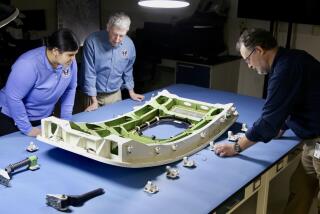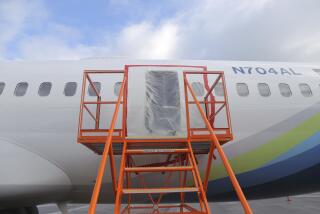Braking System May Have Failed in June Crash
LITTLE ROCK, Ark. — An American Airlines jet that crashed off the end of a wet runway in a storm could have landed safely if all its braking systems had worked properly, aviation experts testified Friday.
Instead, Flight 1420 left the runway still going about 100 mph, then hit a metal lighting structure, broke apart and caught fire. Eleven people died in the June 1 crash at the Little Rock airport, including the pilot.
The McDonnell-Douglas MD-82 landed in heavy rain and 25-mph crosswinds, but that alone was not enough to cause it to run off the runway, according to Boeing Corp. tests exhibited at a National Transportation Safety Board hearing.
The plane’s braking was hindered because it did not use its spoilers--wing panels that help deceleration by putting more weight on the wheels, said Thomas Yager, a NASA research engineer who specializes in runway braking.
With spoilers, 80% of the plane’s weight is placed on its main landing gear, said C.J. Turner, a Boeing engineer. Boeing now owns McDonnell-Douglas.
Without spoilers, less than 30% of the weight remains on the main landing gear, making it much more difficult to brake, Turner said. In a crosswind--as was the case with the accident--without spoilers the main landing gear will bear just 7% of the load.
The flight recorders indicated that the spoilers did not deploy, but it was unclear whether the crew failed to set them or whether there was a mechanical problem.
Co-pilot Michael Origel has testified that he believed Chief Pilot Richard Buschmann set the spoilers to deploy automatically upon landing. But Origel, whose duty it was to confirm the task, said he could not recall the position of the spoiler handle before the accident.
Instances in which spoilers have not deployed when properly set are very rare, said Robert Baker, vice chairman of American Airlines’ parent company, AMR Corp.
The deceleration of Flight 1420 was also impeded because the pilots did not apply wheel brakes until 11 seconds after touchdown--choosing to use manual brakes instead of brakes that deploy automatically.
Representatives of American Airlines and its pilots union questioned whether a flooded runway could also have affected the landing.
But Yager said runway markings showed no evidence of hydroplaning and that the runway was of the highest quality, with good traction and drainage. He said the plane’s tire treads also were good.
Also testifying was Stephanie Manus, who said a child-restraint seat saved her 18-month-old daughter’s life in the crash. She urged the mandatory use of such seats.
More to Read
Inside the business of entertainment
The Wide Shot brings you news, analysis and insights on everything from streaming wars to production — and what it all means for the future.
You may occasionally receive promotional content from the Los Angeles Times.










